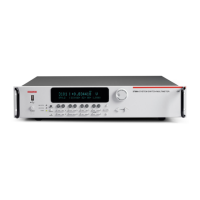dB commands
Expressing DC or AC voltage in decibels (dB) makes it possible to compress a large range of
measurements into a much smaller scope. The relationship between dB and voltage is defined by the
following equation:
Where:
V
IN
: DC or AC input signal.
V
REF
: Specified voltage reference level.
The instrument will read 0 dB when the reference voltage level is applied to the input. If a relative
value is in effect when dB is selected, the value is converted to dB, and then relative offset is applied
to the dB value. If relative offset is applied after dB has been selected, dB has relative offset applied
to it.
The dB calculation takes the absolute value of the ratio V
IN
/V
REF
. The largest negative value of dB is -
160 dB. This will accommodate a ratio of V
IN
= 1 µV and V
REF
= 1000 V.
dB configuration
You can select UNITS (V or dB) from the front panel or from the remote interface.
To select UNITS from the front panel, while the active DMM function is DCV or ACV:
1. Press the CONFIG key.
2. Press the DMM key.
3. Turn the navigation wheel to scroll to the UNITS menu item.
4. Press the navigation wheel (or the ENTER key) to select.
5. Select units: V for voltage or dB for decibels.
6. Press the navigation wheel (or the ENTER key) to set.
7. Press the EXIT key to close the attribute menu.
To select dB configuration over the remote interface:
Set the active DMM function to DCV or ACV and set dmm.dbreference. For example:
dmm.func = "dcvolts"
dmm.dbreference = 5
dB scanning
Each channel in a scan may be configured to use dB.
Create a configuration that has dB enabled for units for the selected function by using the
dmm.configure.set() (on page 11-166) command. Once the configuration exists, use the
dmm.setconfig() (on page 11-227) command to connect the configuration to the appropriate
channels. Now the channels can be added to scanning (see scan.create() (on page 11-315) and
scan.add() (on page 11-309) commands). To remotely control the units for AC and DC volts, use the
dmm.units (on page 11-234) command.

